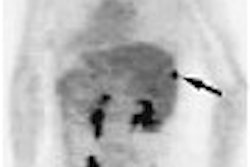Dear AuntMinnie.com Member,
Will researchers someday be able to predict survival rates in cervical cancer patients by using PET to measure gene expression in tumors? Taiwanese researchers have begun laying the groundwork by using FDG to assess glucose uptake in squamous cell carcinoma of the cervix (SCCC), according to an article by staff writer Shalmali Pal that we're featuring in our Molecular Imaging Digital Community this week.
Dear AuntMinnie Member,
Will researchers someday be able to predict survival rates in cervical cancer patients by using PET to measure gene expression in tumors? Taiwanese researchers have begun laying the groundwork by using FDG to assess glucose uptake in squamous cell carcinoma of the cervix (SCCC), according to an article by staff writer Shalmali Pal that we're featuring in our Molecular Imaging Digital Community this week.
Their work is based on genetic research indicating that hypoxia in tumors can result in the overexpression of some types of genes. For their study, the researchers chose to focus on glucose transporter 1 (Glut-1) and its relationship to SCCC.
They theorized that more aggressive tumors require increased glucose for metabolism. Indeed, they found that among the cervical cancer patients they examined, 94.1% showed an overexpression of Glut-1, leading them to link Glut-1 overexpression to FDG uptake. The authors plan to follow up the patients in their study to track survival results.
In another study in the community, Japanese researchers have found that adding CT to FDG-PET scans for ovarian cancer staging can help detect metastases outside the pelvis, which in turn helps stage patients more accurately. This can determine whether some patients are given chemotherapy before surgery.
You can read both articles in our Molecular Imaging Digital Community, at http://molecular.auntminnie.com.




















